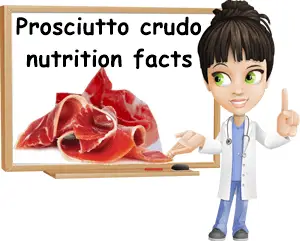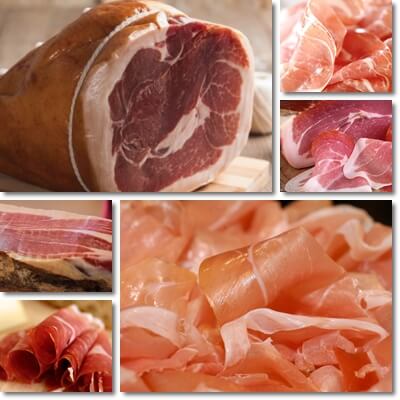Prosciutto crudo, also referred to simply as prosciutto or crudo, is a type of traditional salt-cured Italian ham made exclusively from pork meat. Because it is aged, it does not need to be cooked and can be eaten as it is. Considering the kind of meat it is, prosciutto crudo is naturally a good source of vitamins B1, B2, B3 and B6 as well as vitamin B12, choline, phosphorus, potassium, zinc, copper and selenium. On the downside, prosciutto crudo is high-sodium and a cured red meat which studies say isn’t very healthy in general.
What is prosciutto crudo?
Prosciutto crudo is a traditional Italian ham. It is a salted and dry-cured, aged ham, uncooked, that is. Original Italian prosciutto with PDO certification (Protected Designation of Origin, DOP in Italian) is made exclusively from pork. The cut of meat used for prosciutto crudo is always pig hind leg, more exactly, the thigh or top part of pig hind legs, although the whole leg with bone and pig’s feet is used in many prosciutto specialties. Certified Italian prosciutto crudo is an artisan charcuterie of international recognition. It is a type of salume, a specialty Italian cold cut made from pork.

Is prosciutto crudo healthy?
Prosciutto crudo is not the healthiest food out there, but not the unhealthiest either. Prosciutto in general is a source of important nutrition and contributes significantly to nutritional status. Original prosciutto crudo, with quality certification (DOP, PDO), is definitely healthier than a cheaper ham dubbed prosciutto and overall a healthy food to eat in moderation.
Prosciutto is a type of charcuterie, meaning a cold cut, lunch meat or deli meat. In other words, it is a type of processed meat. That doesn’t sound very healthy, but still, the real prosciutto, that is, the traditional Italian DOP, PDO prosciutto crudo is salt-cured and air-dried only, and does not have any added preservatives, nitrates or nitrites. Prosciutto without certification is just a regular ham and likely has preservatives (typically, the lower the price, the more additives in it).
Prosciutto crudo is also a red meat and recent studies show increased consumption of red meat, especially processed red meat, may potentially lead to higher risks of gastric, intestinal and colon cancers. At the same time, a reasonable intake of red meat contributes to one’s nutrition with essential vitamins and minerals such as vitamin B12, iron, copper and selenium.
Traditional Italian prosciutto crudo with DOP, PDO certification is pure pork meat, essentially a whole pig’s back leg which is a relatively healthy thing to eat in reasonable amounts.
However, lower-quality prosciuttos and hams may be cut with lard or contain various additives such as soy protein, cereal grain or various other meat substitutes that may provide less nutrition or even be a source of side effects (e.g. prosciutto with cereal grain may unknowingly trigger gluten intolerance in predisposed individuals). So is prosciutto healthy? It depends on the prosciutto really. But the higher quality, the least processed and the healthier it is.
Properties of DOP (PDO) prosciutto crudo
- Pure pork meat: Prosciutto crudo is, in fact, a whole pig’s back leg, so it’s pure pork meat.
- Red meat. It is pig back leg.
- Minimally processed: salted and seasoned and hung to air-dry for at least 13 months to up to 2-3 years.
- No preservatives: Italian DOP (PDO) prosciutto, which is the original prosciutto, has no preservatives, no added nitrites or nitrates.
- Sugar-free and gluten-free, although at its widest part, where the lean meat is exposed, the pig leg is covered with grease mixed with cereals to prevent spoilage during curing.
- Uncooked ham. Its name says it’s raw (‘crudo’ in Italian) which is true in the sense that it’s an uncooked ham.
- High-quality and internationally certified: Traditional Italian prosciutto crudo is certified as a PDO (Protected Designation of Origin) or DOP (Denominazione di origine protetta) agricultural food product by the European Union and recognized internationally as an original traditional Italian artisan ham of the highest quality.

Prosciutto crudo nutrition facts
There are actually different types of prosciutto: e.g. Prosciutto di Parma, di San Daniele, di Modena, di Carpegna, Toscano etc. The exact nutritional value of prosciutto crudo differs with each prosciutto, according to variety, curing time, meat quality, pig’s diet and other factors. This being said:
- Prosciutto crudo nutrition facts per 100 g
- Vitamin B1: 0.560 mg
- Vitamin B2: 0.240 mg
- Vitamin B3: 3.88 mg
- Vitamin B6: 0.42 mg
- Vitamin B9: 5 micrograms (mcg)
- Vitamin B12: 0.7 – 0.8 micrograms (mcg)
- Choline: 105 mg
- Vitamin D: trace amounts
- Vitamin E: 0.28 mg
- Calcium: 10 mg
- Copper: 0.1 mg
- Iron: 1.2 – 1.8 mg
- Magnesium: 25 mg
- Phosphorus: 318 mg
- Potassium: 420 – 500 mg
- Selenium: 25 micrograms (mcg)
- Sodium: 1700 – 2300 mg (1.7 – 2.3 g)
- Zinc: 2.8 mg
- Energetic value (calories): 195-265 kilocalories
- Protein: 27-30 g
- Total fat content: 12-17 g
- Saturated fat: 3-5 g
- Cholesterol: 70-83 g
- Carbohydrates: 0 g
- Dietary fiber: 0 g
Note: Vitamin C in the form of ascorbic acid is used as a preservative in some DOP (PDO) prosciuttos such as San Deniele. There is roughly 2.1 mg of ascorbic acid/vitamin C per 100 g of prosciutto crudo.
Benefits of prosciutto crudo
- Good source of vitamin B12 and iron to combat tiredness, fatigue and muscle weakness.
- Good content of B vitamins (B1, B2, B3, B6, B12) – boosts energy levels and restores vitality.
- Anti-anemia food thanks to B vitamins and iron content.
- Source of vitamin B12 and cholesterol – protects the integrity of the myelin sheath coating around the tails of nerve cells, with benefits for nervous system and motor function, as well as protects against early cognitive decline.
- Prosciutto crudo is a great brain food – it supports intellectual effort and cognitive functions thanks to its fat content.
- High in protein, it helps make neurotransmitters for the nervous system that help regulate mood, appetite, sleep and more.
- Benefits for thyroid health and metabolism thanks to selenium content.
- Benefits for bone and teeth health thanks to calcium, magnesium and phosphorus content.
- High-protein and a source of fat, but with virtually no carbohydrates, prosciutto crudo is very low glycemic-index and doesn’t raise blood sugar levels.
What are the side effects of Prosciutto Crudo?
While the many health benefits of prosciutto crudo recommend it for consumption in reasonable amounts, as part of a balanced and varied diet, there are side effects to it too. For one, prosciutto crudo is salt-cured and thus high in sodium. With up to 2.4 g of salt per 100 g, it is sure to cause water retention and eye puffiness, bloating, swollen ankles or legs, swollen arms and similar symptoms.
Just as important, eating too much prosciutto crudo can cause high blood pressure as a result of its high sodium content. Long-term, excess consumption of red meat, processed and unprocessed, is said to increase the risk of some cancers such as colon, gastric or various intestinal cancers.
Very short-term, prosciutto crudo may prove a little too heavy on the stomach for some people, potentially causing indigestion or acid reflux at night which is why it’s important to eat a few slices at a time, preferably at least a couple of hours before going to bed.
